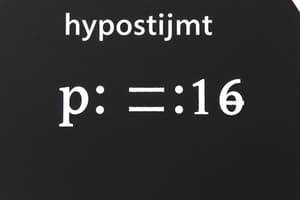Podcast
Questions and Answers
The P-value is the probability of obtaining results at least as extreme as the observed results, assuming the null hypothesis is ______.
The P-value is the probability of obtaining results at least as extreme as the observed results, assuming the null hypothesis is ______.
true
A smaller P-value indicates stronger evidence against the ______ hypothesis.
A smaller P-value indicates stronger evidence against the ______ hypothesis.
null
Type I Error occurs when the null hypothesis is ______ when it is actually true.
Type I Error occurs when the null hypothesis is ______ when it is actually true.
rejected
The probability of making a Type I error is denoted by ______.
The probability of making a Type I error is denoted by ______.
Power of the test is calculated as 1 - ______.
Power of the test is calculated as 1 - ______.
Statistical significance indicates that the observed effect is unlikely to have occurred by ______ alone.
Statistical significance indicates that the observed effect is unlikely to have occurred by ______ alone.
The Null Hypothesis (H0) is a statement asserting no effect or no ______.
The Null Hypothesis (H0) is a statement asserting no effect or no ______.
If P < α, we ______ the null hypothesis, suggesting evidence for the alternative.
If P < α, we ______ the null hypothesis, suggesting evidence for the alternative.
Interpretation of results must be done in ______ to understand their meaning.
Interpretation of results must be done in ______ to understand their meaning.
Setting appropriate hypotheses before data collection is important to avoid ______.
Setting appropriate hypotheses before data collection is important to avoid ______.
Flashcards are hidden until you start studying
Study Notes
Hypothesis Testing
Definition of P-value
- The P-value is the probability of obtaining results at least as extreme as the observed results, assuming the null hypothesis is true.
- A smaller P-value indicates stronger evidence against the null hypothesis.
- Common thresholds for significance:
- P < 0.05: typically considered statistically significant.
- P < 0.01: strong evidence against the null hypothesis.
Type I and II Errors
-
Type I Error (α):
- Occurs when the null hypothesis is rejected when it is actually true.
- The probability of making a Type I error is denoted by α (commonly set at 0.05).
-
Type II Error (β):
- Occurs when the null hypothesis is not rejected when it is actually false.
- The probability of making a Type II error is denoted by β.
- Power of the test = 1 - β, which indicates the probability of correctly rejecting a false null hypothesis.
Statistical Significance
- Statistical significance indicates that the observed effect is unlikely to have occurred by chance alone.
- It is determined through the P-value in relation to the significance level (α).
- It does not imply practical significance; results may be statistically significant but not meaningful in a real-world context.
Hypothesis Formulation
- Null Hypothesis (H0): A statement asserting no effect or no difference, serving as a baseline for comparison.
- Alternative Hypothesis (H1 or Ha): A statement that indicates the presence of an effect or a difference.
- Formulation involves:
- Clearly defining the parameters of interest.
- Setting appropriate hypotheses before data collection to avoid bias.
Interpretation of Results
- After performing hypothesis testing, results must be interpreted in context:
- If P < α: reject the null hypothesis, suggesting evidence for the alternative.
- If P ≥ α: fail to reject the null hypothesis, indicating insufficient evidence to support the alternative.
- Consideration of effect size, confidence intervals, and practical implications is crucial for meaningful interpretation.
- Results should be communicated clearly, highlighting the statistical and practical significance for stakeholders.
P-value
- Represents the probability of observing results as extreme as the actual results, under the assumption that the null hypothesis is correct.
- A smaller P-value signifies stronger evidence against the null hypothesis.
- Common significance thresholds include:
- P < 0.05 indicates statistical significance.
- P < 0.01 signifies strong evidence against the null hypothesis.
Type I and II Errors
- Type I Error (α):
- Involves rejecting the null hypothesis when it is true.
- The probability of occurrence is denoted by α and is typically set at 0.05.
- Type II Error (β):
- Occurs when the null hypothesis is not rejected while it is false.
- The probability of making a Type II error is represented by β.
- Power of the test is equal to 1 - β, determining the likelihood of correctly rejecting a false null hypothesis.
Statistical Significance
- Indicates the unlikelihood that observed effects are due to random chance.
- Determined by comparing the P-value to the predefined significance level (α).
- Does not equate to practical significance; results can be statistically significant yet lack real-world relevance.
Hypothesis Formulation
- Null Hypothesis (H0): States there is no effect or difference, acting as a comparison baseline.
- Alternative Hypothesis (H1 or Ha): Suggests the presence of an effect or difference.
- Proper formulation requires clear definition of parameters and avoiding bias by setting hypotheses prior to data collection.
Interpretation of Results
- Results interpretation is influenced by context:
- If P < α, reject the null hypothesis, suggesting favor for the alternative.
- If P ≥ α, do not reject the null hypothesis, indicating insufficient evidence for the alternative.
- Critical to consider effect size, confidence intervals, and practical implications for a meaningful conclusion.
- Clear communication of results to stakeholders should highlight both statistical and practical significance.
Studying That Suits You
Use AI to generate personalized quizzes and flashcards to suit your learning preferences.




